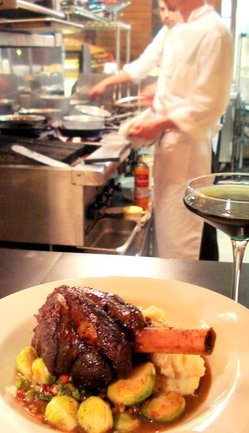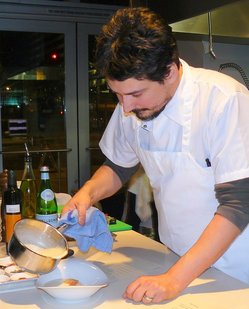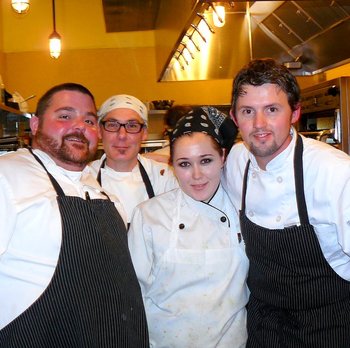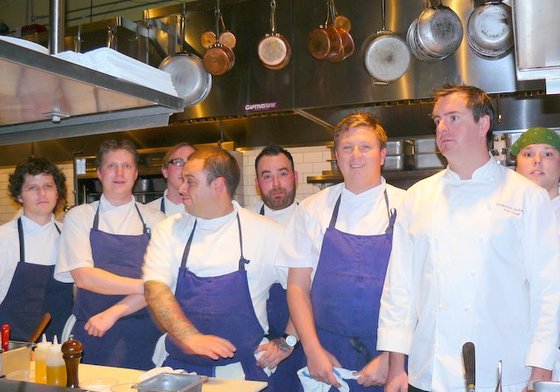 They've been known by several names (25 for $25, 30 for $30, New Urban Eats), these promotional events now called Dine Around and Restaurant Week. The current edition of Restaurant Week runs from Oct. 17th to Oct. 28th, excluding Friday and Saturday nights. Restaurants promote themselves with three-course, $15 lunch menus, $25 for dinner, in hopes of luring new customers to their stores.
They've been known by several names (25 for $25, 30 for $30, New Urban Eats), these promotional events now called Dine Around and Restaurant Week. The current edition of Restaurant Week runs from Oct. 17th to Oct. 28th, excluding Friday and Saturday nights. Restaurants promote themselves with three-course, $15 lunch menus, $25 for dinner, in hopes of luring new customers to their stores.
But restaurants aren't grocery stores, an industry with a long history of loss-leader weekly specials; they're more like small manufacturing businesses, and it's a mistake to think they recover the costs of money-losing promotions.
It's bad math for a restaurant owner to think he can make up the cost of the promotion by doing more businesses (the argument that "we lose $10 on every widdget we make, but we make it up on volume") or acquire new customers (assuming they return when prices return to normal). And it's wrong for customers to wait until prices drop (often by half) to visit a new restaurant.

Let's start with the cost of the promotion itself, regardless of who sponsors it. (The Seattle Times promotes October's upcoming Restaurant Week.) Every participating restaurant contributes close to $1,000 to cover the cost of advertising, giving the Times a windfall of $100,000. I spoke with Carolyn Kelly, the Times president, about restaurants that were unhappy with the promotion; she claimed not to have heard any complaints.
For the current promotion, each participating restaurant contributes $750 to a non-profit association, Seattle Restaurant Cooperative, which purchases advertising. A full 97 percent of the 106 restaurants that participated this spring reported an increase in revenue,according to spokeswoman Heather Jensvold, and the number of participants this time around has risen to 126. (An earlier version of this story erroneously reported that the cost was "nearly $1,000" and that the money was paid directly to the Seattle Times.)
 Many regular customers flee their favorite haunts during these promotions. Some no doubt take off for the competition's cheap meals; the rest don't want to be anywhere the relative chaos of Restaurant Week and its ilk. Menus get more complicated (because the restaurants want to put their best feet forward), service is less polished (because the servers have less training on the temporary menus, or have been hired just for the week). Not many restaurants are equipped to handle a nightly influx of double the number of regular guests. The newby guests, furthermore, tend to be lousy tippers (perhaps in response to lousy service, perhaps because they have no intention of ever returning).
Many regular customers flee their favorite haunts during these promotions. Some no doubt take off for the competition's cheap meals; the rest don't want to be anywhere the relative chaos of Restaurant Week and its ilk. Menus get more complicated (because the restaurants want to put their best feet forward), service is less polished (because the servers have less training on the temporary menus, or have been hired just for the week). Not many restaurants are equipped to handle a nightly influx of double the number of regular guests. The newby guests, furthermore, tend to be lousy tippers (perhaps in response to lousy service, perhaps because they have no intention of ever returning).
 Assuming, though, that all goes well: that a small, neighborhood mom & pop gets through the ten-day "week" with 500 covers, twice as many as usual. (That's $2 per guest for the Seattle Times.) Whatever the restaurant's normal average check (let's say $50), it's going to be less during the promotion. Some higher-ticket restaurants face a drop of $20 per customer during Restaurant Week.
Assuming, though, that all goes well: that a small, neighborhood mom & pop gets through the ten-day "week" with 500 covers, twice as many as usual. (That's $2 per guest for the Seattle Times.) Whatever the restaurant's normal average check (let's say $50), it's going to be less during the promotion. Some higher-ticket restaurants face a drop of $20 per customer during Restaurant Week.
No restaurant owners would speak for attribution, but many face the approach of promotional weeks with the excitement of Opening Night and the dread of a trip to the dentist. "Most restaurant owners like Restaurant Week, but that doesn't mean it's a good idea for every restaurant," an industry observer told me, but he didn't want to be named because he's involved in a competing sector of the marketing business. Yes, promotional events put "butts in seats" (as the saying goes), yes they help fill "excess capacity." But restaurant seats are not like empty spots on the "Ride the Duck" tour bus; it costs money to cook and serve meals to each additional customer.
 Many restaurant cooks approach Restaurant Week promotions with their customary macho swagger and competitiveness. They've got to produce a three-course menu for the standard 35 percent ingredient cost or they're in deep trouble. And the menus themselves are public knowledge, published on the Seattle Times website. "My $8-food-cost menu is going to blow you away," they say to their rivals down the street. You look at the dishes, and you know somebody's not being entirely truthful; there's no way you can put that much food on a plate for $8.
Many restaurant cooks approach Restaurant Week promotions with their customary macho swagger and competitiveness. They've got to produce a three-course menu for the standard 35 percent ingredient cost or they're in deep trouble. And the menus themselves are public knowledge, published on the Seattle Times website. "My $8-food-cost menu is going to blow you away," they say to their rivals down the street. You look at the dishes, and you know somebody's not being entirely truthful; there's no way you can put that much food on a plate for $8.
Assaggio, maybe. At dinner ($8 ingredient cost): a salad, some braised pork shoulder, gelato; at lunch ($5 ingredient cost) soup, pasta, panna cotta. But Rover's? At dinner, smoked salmon, Pacific cod with lobster mushrooms, espresso crème brûlée for $8? Impossible. Fine, you say, owner Thierry Rautureau spends more on ingredients. And I say, either he's got to make it up somewhere else or he's willing to lose $5 a plate (or maybe much more) in the name of bringing in new customers.
And assuming that's true, I have two more questions for restaurant owners: why in the world would you turn your back on your regulars, who support you and your elegant, high-priced dinners year-round, for the purpose of bringing in dozens of bargain-hunting cheapskates who would never pay your everyday prices? (If General Motors sold Cadillacs for $5,000 for one week a year, why would you buy a Cadillac when it's not on sale?) Why, in other words, are you training your customers to pay half price? Promotions like Restaurant Week are self-inflicted poison, slow suicide. A minority viewpoint, no doubt (who doesn't want to save money?), but If I go to a participating restaurant during the promotion, I'm abetting the suicide.

Getting a slower start this morning, still on my first cup of coffee, almost spit it out accross my desk and onto the computer screen. That title is funny! This isn't a fit for all 126 locations, value engineering is the name of the game. The numbers, and halo effect would be interesting.
Getting a slower start this morning, still on my first coffee and almost spit it out across my desk and onto the computer screen: god you are funny!Some will fail and some will succeed, the details will be telling. Value engineering at it's most extreme.